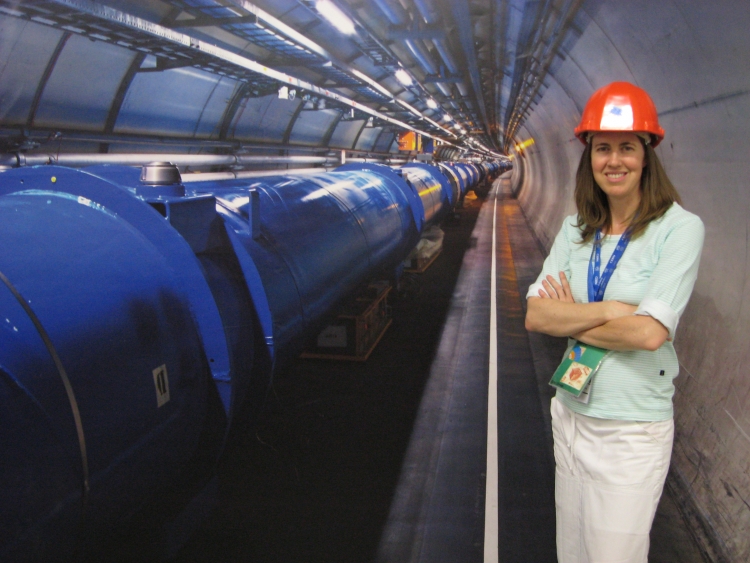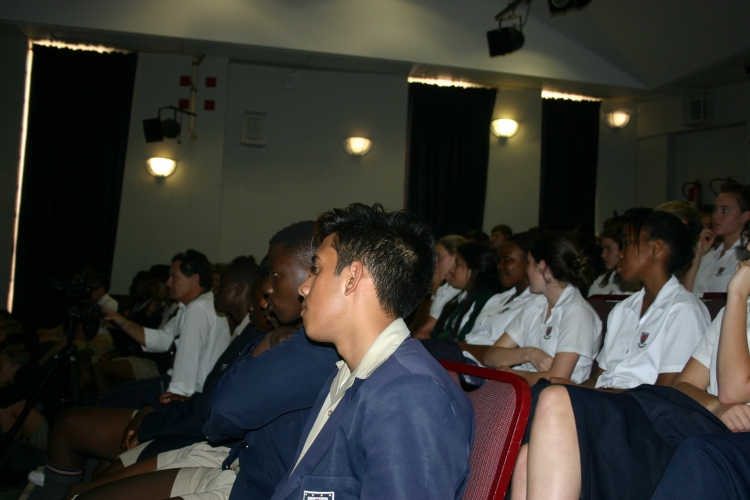From Quarks to the Cosmos: CERN Physicist Dr Claire Lee gives Public Lecture at Saints
High Energy Physics is fascinating! Better known as Particle Physics, it’s the study of the fundamental building blocks of the Universe and the interactions that govern it.
Particle physics is famously complex, but also super cool and intriguing, as demonstrated in our recent public lecture by Dr Claire Lee.
Saints’ Privilege to host a Public Lecture from CERN Physicist
On 16 March 2017, Physical Science students from the Boys’ College and the Girls’ College had the privilege to attend a public lecture by Dr Claire Lee. Dr Claire Lee is a particle physicist on the ATLAS experiment at CERN (the European Organization for Nuclear Research) in Switzerland. She is part of the team of physicist who helped discover the Higgs boson: a particle which shot to fame when it was discovered in 2012 and awarded Peter Higgs and Francois Englert with a Nobel Prize in Physics in 2013! Claire Lee has given TEDx talks in Europe, judged in the Swiss FameLab competitions, addressed the United Nations at the UNESCO celebrations in 2014, and has been nominated as one of the Top Young South Africans by the Mail & Guardian. Originally from South Africa, she now lives with her family in France near the Swiss border.
Dr Lee was invited to St Stithians College by Ms Lizelle Swanepoel of the Boys’ College Science Department, who attended a 3-week residential course in modern physics (particle physics, astrophysics and cosmology) at CERN in 2015. Through international collaboration with selected teachers from 32 countries (including several European and Asian countries, Canada, America, the UK, China, India, the Azores, Finland, Denmark, Sweden, Norway, Brazil and South Africa) Ms Swanepoel has become an ambassador for CERN and for modern science. The Boys’ College Science Department recognises the ability of science teachers to instil a feeling of mystery and discovery potential in its students and engages in strategies to bring modern science into the classroom. Public lectures by expert scientists, like Dr Lee, offer our students direct insight into modern science and the importance of research at the frontiers of discovery.

Some Insight into the Largest Physics Lab in the World
CERN is the largest physics laboratory in the world. It does research on the most fundamental particles of matter, by colliding protons into each other at speeds near the speed of light. It uses a 27 km long circular particle accelerator, the Large Hadron Collider (LHC), to achieve these high energy collisions. Founded in 1952, by scientists from twelve European countries and under the auspices of UNESCO, CERN’s research is public and purely scientific and may not be used for military applications. Following the ideals of its founders, the laboratory contributes to strengthening peace in Europe and its member state countries. The CERN model of collaboration between more than 10 000 researchers, from more than 100 nationalities, has become global and remains an example to others.
The CERN laboratory sits on the Swiss-French border (100 m underground) near Geneva and is the birthplace of the World Wide Web, touch screen technology, PET and CT scan sensors, the LHC as the largest single machine ever built, the Higgs boson which gives all matter mass through the Higgs mechanism, and antimatter! CERN is a place where the best scientists, engineers and professionals collaborate from all corners of the globe to explore the unknown and to advance their fields. It is truly one of the most inspiring places on Earth from a scientific point of view!
Quarks to the Cosmos Lecture
Dr Claire Lee gave a vibrant lecture on some complex quantum concepts in particle physics. This field of physics falls outside the scope of our current high school curriculum in South Africa, but our students were engaged and followed intently. They heard about the smallest particles and the largest galaxies, and the fundamental forces that govern every particle in the Universe.
Our best understanding of how these elementary particles and three of the fundamental forces interact is explained in the Standard Model of particle physics. The Standard Model is a quantum field theory, which is highly successful in calculations to predict and explain the behaviour of fundamental particles. These fundamental particles vary in “colour”, “flavour”, spin, charge and mass and have rather strange names like quarks, muons, taus, neutrinos, gluons, W and Z bosons. The list goes on. Quarks build up ordinary matter (containing protons and neutrons) and come in six flavours: up, down, top, bottom, charm and strange. Each particle also has its own antiparticle with the same mass as its particle counterpart, but with opposite charge. To add to the strangeness, antimatter is made in the antimatter factory (in the ELENA experiment) at CERN. This seems like the stuff science fiction is made of, but it is as real as normal matter we see around us! Our students were blown away by the fact that normal matter only contributes 5% of our known Universe. The rest of the Universe is made up of dark matter (25%) and dark energy (70%), which cannot be seen due to the fact that they do not interact with light.

Talking about Technological Spin-offs from Particle Physics
Students also learnt about numerous spin-off technologies that have come out of CERN. Some of these technologies and inventions deserve a mention. The World Wide Web was invented at CERN by scientist Tim Berners-Lee and was originally developed for automatic sharing of information between scientists around the world. The first modern touch screen was invented and developed at CERN in 1973 to perform multiple functions in the control room of its second largest machine, the Super Proton Synchrotron (SPS). PET and CT scans also originated from CERN and has revolutionized the medical industry in terms of imaging and diagnosis. The latest methods of cancer treatment, called hadron therapy and carbon therapy, were invented and developed at CERN.
Opening up modern STEM careers for our Future Scientists and Engineers
This public lecture has highlighted to our scientifically inclined students that it is possible to follow highly successful STEM careers in complex modern science fields. The opportunity to interact with a distinguished scientist who works at the frontiers of discovery in physics, has been most valuable. It has also made them think about very profound questions that must be answered by science. We need to give our students many opportunities to think and to explore, beyond the scope of a set curriculum. That way we can prepare our youth for membership in a future meritocracy, which will reward merit and critical and analytical thinking. These qualities we, as educators, need to foster for advancing education in a global society.
Article by: Ms Lizelle Swanepoel
Lizelle Swanepoel is a Physical Science teacher at St Stithians Boys’ College in Johannesburg, and is passionate about Science. She has published articles on the topic of bringing modern science into the classroom in various science journals/magazines, including the following: CERN Courier (Journal for High Energy Physics, CERN Switzerland), Physics Comment (Journal Publication of the South African Institute of Physics, SAIP) and the WattNow magazine (Publication of the South African Institute of Electrical Engineering, SAIEE). She is an ambassador for CERN (The European Organisation for Nuclear Research in Geneva, Switzerland) and has been selected as one of fifty teachers worldwide to represent the African continent in attending a 3-week residential course in particle physics, astrophysics and cosmology in 2015. She has a B.Sc (Hons) in Chemistry and a post-grad certificate in Education (PGCE) from the University of the Free State. She enjoys spending time in nature, stargazing, reading (about “sciency” things) and mountain biking (of sorts).






